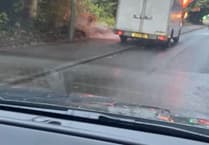Crew members at Farnham’s branch of Surrey Fire and Rescue Service are warning of increased wildfire danger as summer approaches.
The team has recently been tackling blazes in Ash Ranges and is urging the public to stay alert to the risks, especially in vulnerable nearby areas such as Frensham Common, Hankley Common, and Thursley Common.

This week, the Herald visited Farnham Fire Station on Guildford Road to learn more about the work being done by Blue Watch and what a typical day involves.
Watch Commander Dave Marsh said: “We want people to be careful during these warm summer months especially when it comes to disposing of barbeques and rubbish. Bonfires can also cause fires when the winds pick up and hot embers can create ‘spot-fires’.”
Farnham Fire Station responds to a wide variety of incidents across the county, including road traffic collisions, house fires, animal rescues, and other emergencies. The team also specialises in tackling wildfires, which are becoming an increasing threat during hot, dry spells.
The station is home to three main firefighting vehicles: a standard fire engine for most types of incidents and two multi-terrain vehicles equipped for off-road operations.
One is a Land Rover fitted with a Fire Fogging System, used to control and suppress wildfires. The other is the Unimog H4T, a large 4x4 designed to handle rugged terrain. While the Unimog can be slow on roads—sometimes frustrating drivers stuck behind it—it excels off-road, where it plays a key role in accessing remote wildfire sites.

Each vehicle carries specialised tools and battery-powered equipment to allow firefighters to work safely and effectively in challenging conditions.
Farnham Fire Station is staffed by four watches: Red, White, Blue, and Green. On duty during the visit were the four members of Blue Watch: Watch Commander Dave Marsh, Crew Commander Josh Berry, and firefighters Tom Paige and Sean Smith.
The shift begins with a 9am parade, where the outgoing and incoming watches share updates on incidents and equipment use. This daily routine ensures smooth transitions and operational readiness.
Training is a key part of the job. Given the wide range of equipment and scenarios firefighters face, each day includes a practical exercise.
On this visit, the crew focused on ventilation training—an essential skill for managing smoke in fires. Using a smoke machine, they filled a corridor with thick smoke, limiting visibility to just inches. Working together over radio, the team coordinated the use of fans to ventilate the space and simulate a real-life rescue situation.
Smoke in most fire scenarios is generally more dangerous than the fire itself, a crew member explained. This is because while the fire can cause burns and damage, smoke inhalation can lead to more fatalities and injuries due to toxic gases and asphyxiation.
With the combination of dry conditions and excess vegetation from a wet winter, Farnham firefighters are urging caution.
As the region braces for a potentially hazardous fire season, Farnham Fire Station’s message is clear: prevention is key.






Comments
This article has no comments yet. Be the first to leave a comment.